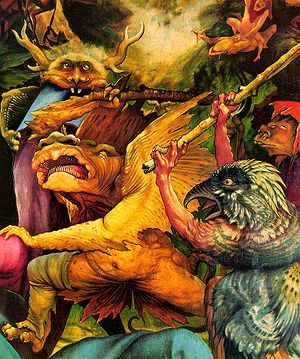Hallucination

Hallucination (from Latin: (h)alūcinātio "thoughtless talk, reverie"; from Greek: ἀλύειν halýein "to be out of one's mind") is a perception of a sensory area without a stimulus basis. This means, for example, that non-existent objects are seen, or voices are heard without anyone speaking. Hallucinations can affect all sensory areas. In an illusion, on the other hand, a real object is perceived in a different way: An actually existing fixed object appears to move or faces appear to be recognisable in irregular patterns.
By definition, a hallucination has the character of reality for the hallucinating person or cannot be distinguished from reality. In contrast, in a pseudohallucination, the person realises that it is not a real perception. Pseudohallucinations can also occur during overtiredness and half-sleep.
Literature
- Hans-Jürgen Möller, Gerd Laux und Arno Deister: Psychiatrie und Psychotherapie, Thieme Verlag
- Rudolf Steiner: Geist und Stoff, Leben und Tod, GA 66 (1988), ISBN 3-7274-0660-7 English: rsarchive.org German: pdf pdf(2) html mobi epub archive.org
- Rudolf Steiner: Anthroposophie, ihre Erkenntniswurzeln und Lebensfrüchte, GA 78 (1986), ISBN 3-7274-0780-8 English: rsarchive.org German: pdf pdf(2) html mobi epub archive.org
- Rudolf Steiner: Die Wirklichkeit der höheren Welten, GA 79 (1988), ISBN 3-7274-0790-5 English: rsarchive.org German: pdf pdf(2) html mobi epub archive.org
- Rudolf Steiner: Wie erwirbt man sich Verständnis für die geistige Welt?, GA 154 (1985), ISBN 3-7274-1540-1 English: rsarchive.org German: pdf pdf(2) html mobi epub archive.org
- Rudolf Steiner: Christus und die menschliche Seele, GA 155 (1994), ISBN 3-7274-1550-9 English: rsarchive.org German: pdf pdf(2) html mobi epub archive.org
- Rudolf Steiner: Menschenwerden, Weltenseele und Weltengeist – Erster Teil, GA 205 (1987), ISBN 3-7274-2050-2 English: rsarchive.org German: pdf pdf(2) html mobi epub archive.org
- Rudolf Steiner: Die Anthroposophie und ihre Gegner 1919 – 1921, GA 255b (2003), ISBN 3-7274-2555-5 English: rsarchive.org German: pdf pdf(2) html mobi epub archive.org
 |
References to the work of Rudolf Steiner follow Rudolf Steiner's Collected Works (CW or GA), Rudolf Steiner Verlag, Dornach/Switzerland, unless otherwise stated.
Email: verlag@steinerverlag.com URL: www.steinerverlag.com. Index to the Complete Works of Rudolf Steiner - Aelzina Books A complete list by Volume Number and a full list of known English translations you may also find at Rudolf Steiner's Collected Works Rudolf Steiner Archive - The largest online collection of Rudolf Steiner's books, lectures and articles in English. Rudolf Steiner Audio - Recorded and Read by Dale Brunsvold steinerbooks.org - Anthroposophic Press Inc. (USA) Rudolf Steiner Handbook - Christian Karl's proven standard work for orientation in Rudolf Steiner's Collected Works for free download as PDF. |
[[Category:
